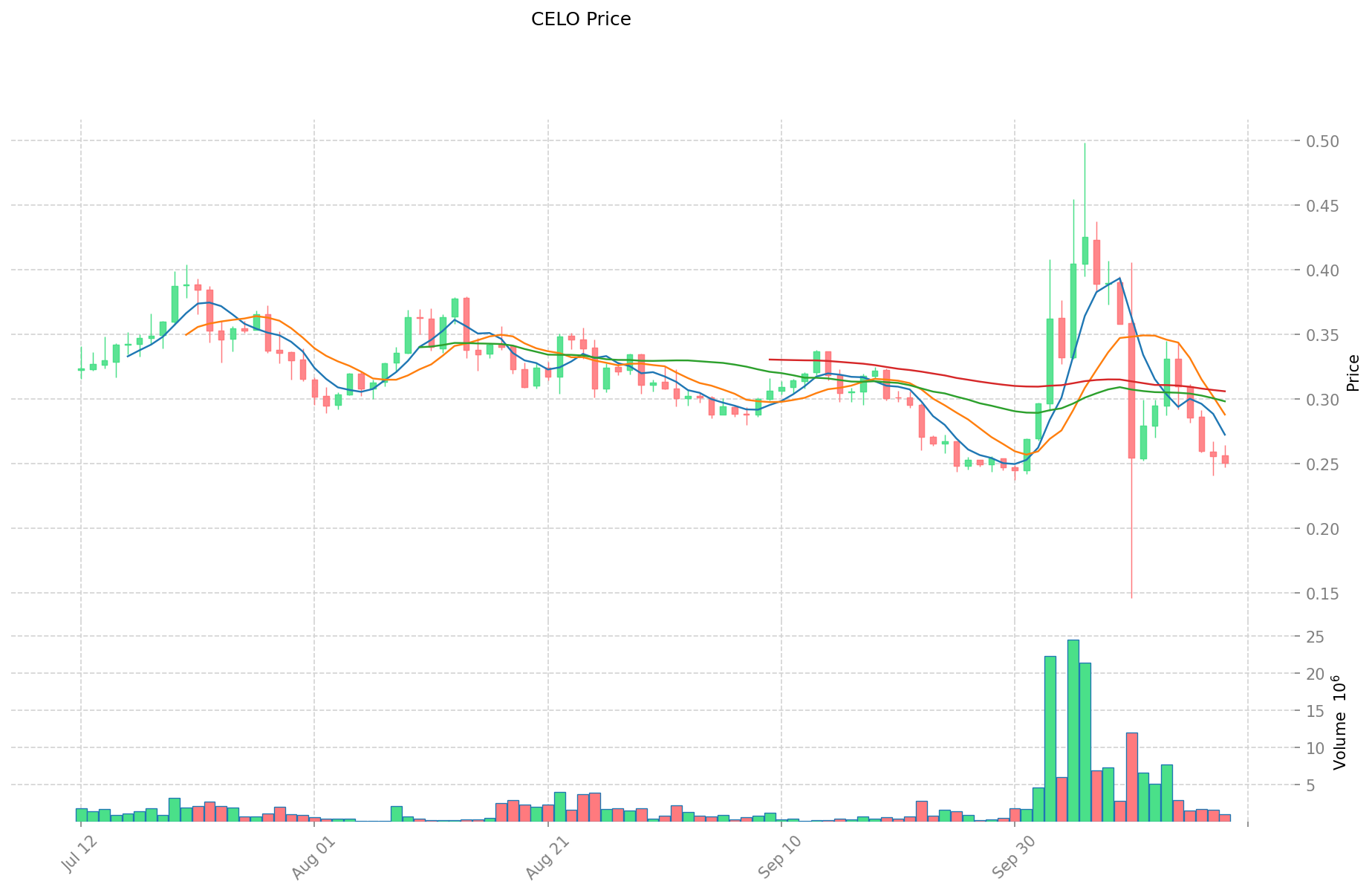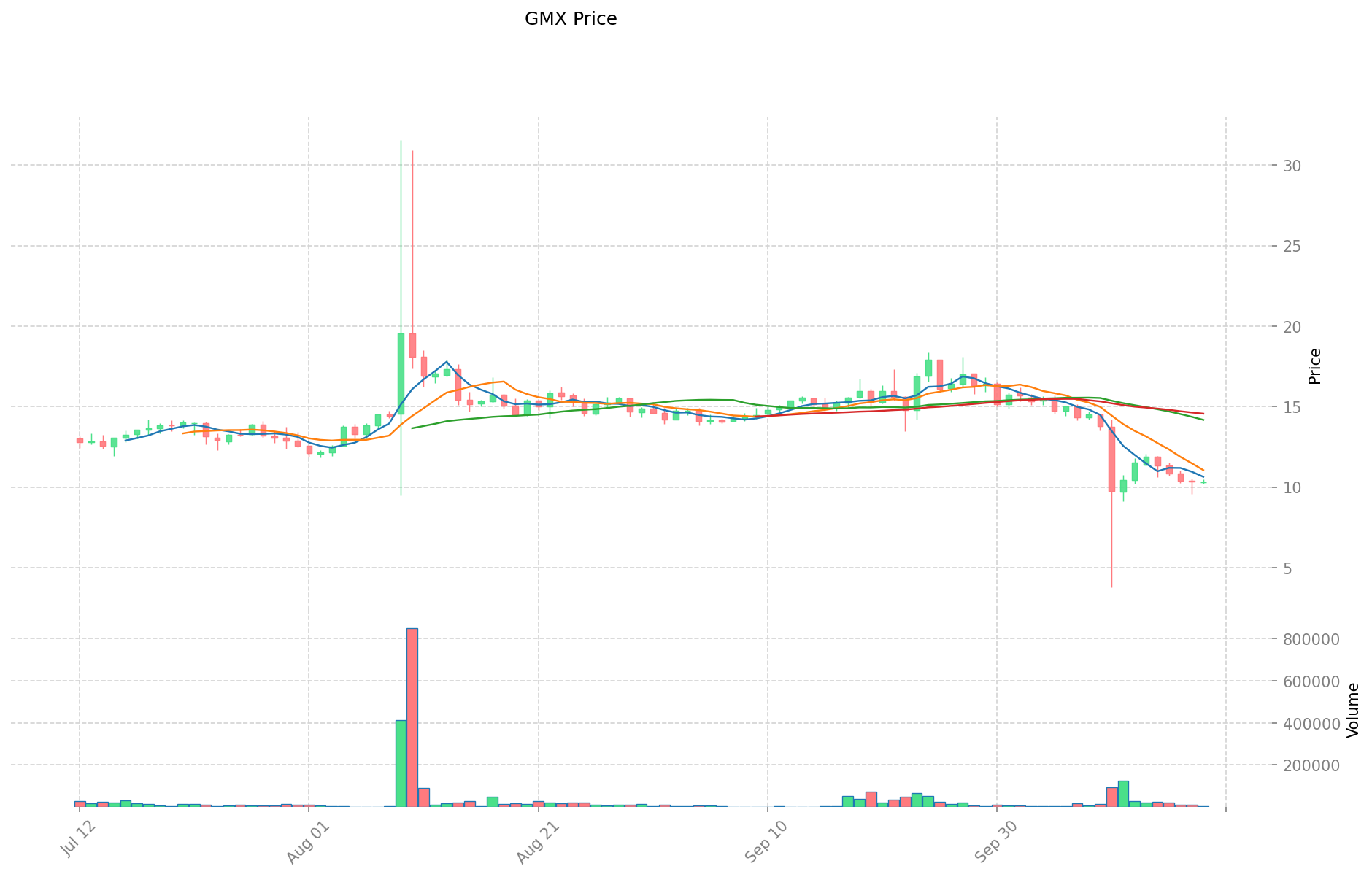CELO vs GMX: Comparing Two Innovative Blockchain Platforms for DeFi and Beyond
Introduction: CELO vs GMX Investment Comparison
In the cryptocurrency market, the comparison between CELO and GMX has been an unavoidable topic for investors. The two not only show significant differences in market cap ranking, application scenarios, and price performance, but also represent different positioning in the crypto asset landscape.
CELO (CELO): Since its launch, it has gained market recognition for its commitment to financial inclusion and mobile-first approach to blockchain solutions.
GMX (GMX): Established as a decentralized perpetual exchange, GMX has carved out its niche in the DeFi space with its unique tokenomics and governance model.
This article will comprehensively analyze the investment value comparison between CELO and GMX, focusing on historical price trends, supply mechanisms, institutional adoption, technological ecosystems, and future predictions, attempting to answer the question investors are most concerned about:
"Which is the better buy right now?"
I. Price History Comparison and Current Market Status
CELO and GMX Historical Price Trends
- 2021: CELO reached its all-time high of $9.82 on August 30, 2021.
- 2023: GMX hit its all-time high of $91.07 on April 18, 2023.
- Comparative analysis: CELO has fallen from its all-time high of $9.82 to a current price of $0.249, while GMX has dropped from $91.07 to $10.3.
Current Market Situation (2025-10-19)
- CELO current price: $0.249
- GMX current price: $10.3
- 24-hour trading volume: CELO $262,406.404368 vs GMX $41,889.43709
- Market Sentiment Index (Fear & Greed Index): 29 (Fear)
Click to view real-time prices:
- View CELO current price Market Price
- View GMX current price Market Price


II. Core Factors Affecting Investment Value of CELO vs GMX
Supply Mechanism Comparison (Tokenomics)
- CELO: Progressive issuance model with target of 1 billion tokens. Current circulating supply is approximately 532 million. Features an elastic supply mechanism that attempts to maintain price stability.
- GMX: Fixed maximum supply of 13.25 million tokens with deflationary characteristics. 30% of platform fees are used for GMX token buyback and distribution.
- 📌 Historical pattern: GMX's deflationary model has created stronger price support during market downturns, while CELO's larger supply has shown more price volatility.
Institutional Adoption and Market Applications
- Institutional holdings: GMX has attracted more trading-focused institutions due to its high yield generation, while CELO has more strategic investors interested in mobile payments infrastructure.
- Enterprise adoption: CELO has stronger enterprise applications through mobile payment solutions and remittances in emerging markets. GMX focuses primarily on decentralized perpetual trading functionality.
- Regulatory attitudes: CELO has more regulatory clarity due to its focus on financial inclusion and compliance efforts, while GMX faces potential regulatory uncertainty as a decentralized derivatives platform.
Technical Development and Ecosystem Building
- CELO technical upgrades: Recent integration with Ethereum's EIP-4844 data blobs, implementation of account abstraction, and continued development of mobile-first infrastructure.
- GMX technical development: Launch of GMX V2 with improved liquidity management, multi-asset collateral support, and enhanced yield mechanisms for token holders.
- Ecosystem comparison: CELO has a broader ecosystem spanning mobile payments, microfinance, and humanitarian applications. GMX has a more focused ecosystem centered on decentralized derivatives trading with deeper liquidity and trading volume.
Macroeconomic and Market Cycles
- Inflation environment performance: GMX has shown more resilience during inflationary periods due to fee-generating model and lower token emissions.
- Macroeconomic monetary policy: Rising interest rates have historically impacted CELO more negatively, while GMX performance correlates more directly with trading volume and market volatility.
- Geopolitical factors: CELO has stronger positioning in regions with currency instability and remittance needs. GMX benefits from increased market volatility during geopolitical tensions.
III. 2025-2030 Price Prediction: CELO vs GMX
Short-term Prediction (2025)
- CELO: Conservative $0.20-$0.25 | Optimistic $0.25-$0.34
- GMX: Conservative $8.14-$10.30 | Optimistic $10.30-$14.73
Mid-term Prediction (2027)
- CELO may enter a growth phase, with estimated prices of $0.26-$0.38
- GMX may enter a strong bullish phase, with estimated prices of $12.01-$21.32
- Key drivers: Institutional capital inflow, ETF developments, ecosystem growth
Long-term Prediction (2030)
- CELO: Base scenario $0.39-$0.50 | Optimistic scenario $0.50-$0.60
- GMX: Base scenario $23.40-$25.27 | Optimistic scenario $25.27-$30.00
Disclaimer: This analysis is based on historical data and market projections. Cryptocurrency markets are highly volatile and unpredictable. This information should not be considered as financial advice. Always conduct your own research before making investment decisions.
CELO:
| 年份 | 预测最高价 | 预测平均价格 | 预测最低价 | 涨跌幅 |
|---|---|---|---|---|
| 2025 | 0.336015 | 0.2489 | 0.204098 | 0 |
| 2026 | 0.32170325 | 0.2924575 | 0.20472025 | 17 |
| 2027 | 0.38385046875 | 0.307080375 | 0.26101831875 | 23 |
| 2028 | 0.36964800140625 | 0.345465421875 | 0.3247374965625 | 38 |
| 2029 | 0.414765785503125 | 0.357556711640625 | 0.253865265264843 | 43 |
| 2030 | 0.502009623143437 | 0.386161248571875 | 0.204665461743093 | 55 |
GMX:
| 年份 | 预测最高价 | 预测平均价格 | 预测最低价 | 涨跌幅 |
|---|---|---|---|---|
| 2025 | 14.729 | 10.3 | 8.137 | 0 |
| 2026 | 17.5203 | 12.5145 | 11.638485 | 21 |
| 2027 | 21.324708 | 15.0174 | 12.01392 | 45 |
| 2028 | 23.80408074 | 18.171054 | 15.26368536 | 76 |
| 2029 | 25.8147078651 | 20.98756737 | 17.6295565908 | 103 |
| 2030 | 25.273228626954 | 23.40113761755 | 17.0828304608115 | 127 |
IV. Investment Strategy Comparison: CELO vs GMX
Long-term vs Short-term Investment Strategy
- CELO: Suitable for investors focused on financial inclusion and mobile payment solutions
- GMX: Suitable for investors seeking yield generation and exposure to decentralized derivatives trading
Risk Management and Asset Allocation
- Conservative investors: CELO: 30% vs GMX: 70%
- Aggressive investors: CELO: 40% vs GMX: 60%
- Hedging tools: Stablecoin allocation, options, cross-currency portfolios
V. Potential Risk Comparison
Market Risk
- CELO: Higher volatility due to larger supply and elastic supply mechanism
- GMX: Dependency on trading volume and market volatility for fee generation
Technical Risk
- CELO: Scalability, network stability
- GMX: Smart contract vulnerabilities, liquidity risks
Regulatory Risk
- Global regulatory policies may have different impacts on both assets, with CELO potentially facing less scrutiny due to its focus on financial inclusion
VI. Conclusion: Which Is the Better Buy?
📌 Investment Value Summary:
- CELO advantages: Strong positioning in mobile payments and emerging markets, broader ecosystem
- GMX advantages: Deflationary tokenomics, high yield potential, strong performance in volatile markets
✅ Investment Advice:
- New investors: Consider a balanced approach with a slight preference for GMX due to its more stable price history
- Experienced investors: Explore strategies that leverage GMX's yield generation while maintaining exposure to CELO's long-term potential
- Institutional investors: Consider GMX for trading operations and CELO for strategic investments in mobile financial infrastructure
⚠️ Risk Warning: Cryptocurrency markets are highly volatile. This article does not constitute investment advice. None
VII. FAQ
Q1: What are the key differences between CELO and GMX? A: CELO focuses on financial inclusion and mobile-first blockchain solutions, while GMX is a decentralized perpetual exchange. CELO has a larger supply with an elastic mechanism, while GMX has a fixed supply with deflationary characteristics. CELO has broader applications in mobile payments and remittances, while GMX specializes in decentralized derivatives trading.
Q2: Which token has performed better historically? A: GMX has shown better historical performance. While CELO reached its all-time high of $9.82 in 2021 and has since fallen to $0.249, GMX hit its all-time high of $91.07 in 2023 and is currently trading at $10.3. GMX's deflationary model has also provided stronger price support during market downturns.
Q3: How do the supply mechanisms of CELO and GMX differ? A: CELO has a progressive issuance model with a target of 1 billion tokens and an elastic supply mechanism. GMX has a fixed maximum supply of 13.25 million tokens with deflationary characteristics, as 30% of platform fees are used for token buyback and distribution.
Q4: Which token is more suitable for long-term investment? A: Both tokens have long-term potential, but for different reasons. CELO may be more suitable for investors focused on financial inclusion and mobile payment solutions in emerging markets. GMX might be preferable for those interested in yield generation and exposure to the growing decentralized derivatives trading sector.
Q5: What are the main risks associated with investing in CELO and GMX? A: For CELO, risks include higher volatility due to its larger supply, potential scalability issues, and network stability. GMX faces risks related to smart contract vulnerabilities, liquidity risks, and dependency on trading volume and market volatility for fee generation. Both tokens are subject to regulatory risks, though CELO may face less scrutiny due to its focus on financial inclusion.
Q6: How do institutional adoptions differ between CELO and GMX? A: GMX has attracted more trading-focused institutions due to its high yield generation potential. CELO, on the other hand, has more strategic investors interested in mobile payments infrastructure and financial inclusion initiatives.
Q7: What are the price predictions for CELO and GMX by 2030? A: According to the provided predictions, by 2030, CELO's base scenario price range is $0.39-$0.50, with an optimistic scenario of $0.50-$0.60. For GMX, the base scenario price range is $23.40-$25.27, with an optimistic scenario of $25.27-$30.00. However, it's important to note that these are projections and actual prices may vary significantly due to market volatility and unforeseen factors.
Share
Content